Just for fun.
Find and identify the bird(s) in this picture. It was taken in my backyard a couple of days ago.

Find and Identify the backyard bird(s) in the image.

Just for fun.
Find and identify the bird(s) in this picture. It was taken in my backyard a couple of days ago.

Find and Identify the backyard bird(s) in the image.
It’s been pretty quiet on the birding front but I decided to go on the Nanaimo/Parksville Sunday bird walk to Bowen Park. In the heart of Nanaimo, this park is a jewel with most of its 36 hectares undeveloped.
The walk starts in the parking lot, near the first hole of Nanaimo’s Disk Golf course where we quickly spotted a Brown Creeper while waiting for the group to assemble. This one was quite vocal (for a Creeper) emitting a double note call at fairly regular intervals making us wonder if it was a young bird.


It was pretty quiet today. There were no Starlings or House Sparrows which helped keep the BQI (Bird Quality Index) high.
Shortly after we started down the birding trail we discovered a fairly large paper wasp nest. What I liked was the colour and pattern — different from the grey nests I am used to. Perhaps mocha is this year’s colour in paper-wasp real-estate.
A bit further, someone noticed an interesting spider web hanging between trees. With a bit of light that made it through the thick forest canopy it looked a bit like a suspended compact disk.
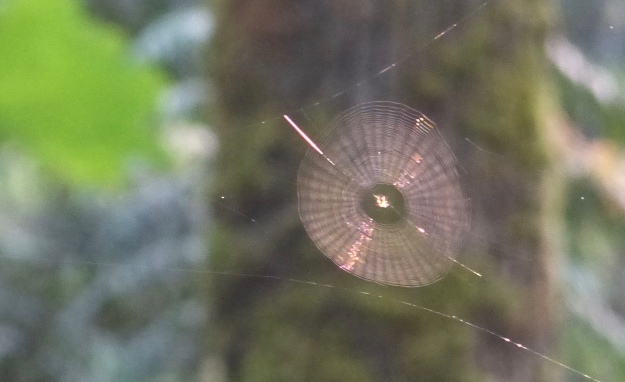
Next along the way was a Pacific-slope Flycatcher, making short foraging flights, returning to the same perch. He was quite cooperative, hanging out a few meters from the path so that everyone could get a good look or take a few pictures.
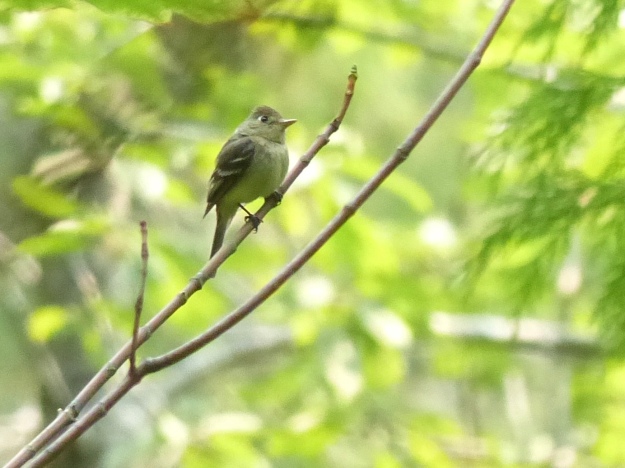
Pileated Woodpeckers frequently are oblivious to us birder-humans as we take shot after shot while they peck away at the trees. This female was pecking at various trees, occasionally do light renovations to existing holes. With the dark under-canopy, the camera shutter speed was in the 1/100 to 1/200 range so you had to snap your shot during the bird’s brief bouts of pounding or the image would be heavily blurred.


We saw a Barred Owl along the way but getting a good image would have been a challenge so I didn’t even try. The following two owls, however, cooperated with my picture taking:

Almost at the end of our outing, we found our ‘Bird of the Day’ — an American Dipper. It was hanging out in a shaded spot at the edge of the Millstone River. The BQI definitely jumped when we found this bird.

That was it. About three hours at Bowen Park. Total species count: 25.
This walk was organized by the Nanaimo Backyard Wildbird and Nature Store. They can be contacted for more information on future Sunday or Tuesday outings.
I dislike unhappy stories and enjoy writing about them even less. However, I have to remind myself that not everything is about the birds — Mother Nature is a much more clever scriptwriter than that.
I mentioned in my last post that there were some moving specks on the vinyl siding behind the nest that I suspected might be some kind of bird mite. Here is what my research found.
At the end I share my opinions as to the effect that the mites had on the nestling development and their departure from the nest.
I went back and looked at video footage to look for evidence of moving specks which I would later confirm to be mites. It turns out that a good way to see them is to fast-forward the video and watch closely — the mites are easy to see when moving, especially those on the light coloured vinyl siding.
I found the first mite evidence in the July 19 webcam footage — (hatch-day + 8). On subsequent days, the quantity of mites increasing dramatically, dare I say ‘exponentially’, until the three nestlings left the nest on July 23. While the initial mites were only seen while moving on the vinyl siding, by July 21 large immobile clusters of mites could be seen on the outdoor light fixture. Here is a picture taken on July 22 with my Panasonic FX-200 camera:
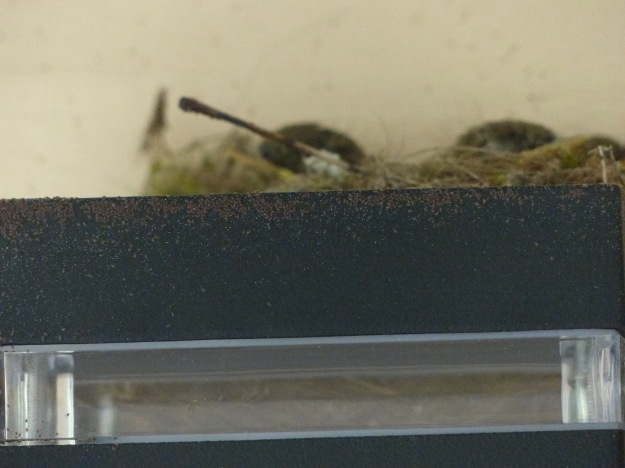
Mites grouping on the outdoor light fixture.
The out-of-focus mites are still visible on the siding behind the nest. More obvious are the the brown patches on the black edge of the light fixture in which individual mites are easily visible. The reddish-brown colour comes from mites that have all taken some blood, probably from one of the nestlings (’empty’ unfed mites are light coloured).
To study the mites more closely, I ran a lint roller along the edge of the light fixture. This was surprisingly effective at removing all of the mites in its path. The sticky lint-roller paper immobilized most of the mites however there were still a number of wandering mites so I sprayed the sample with a mixture of bleach and water to make sure the mites were dead before the sample came into the house.
To demonstrate the mite size and numbers, I took a picture showing a section of lint-roller paper with mites next to a Canadian dime:
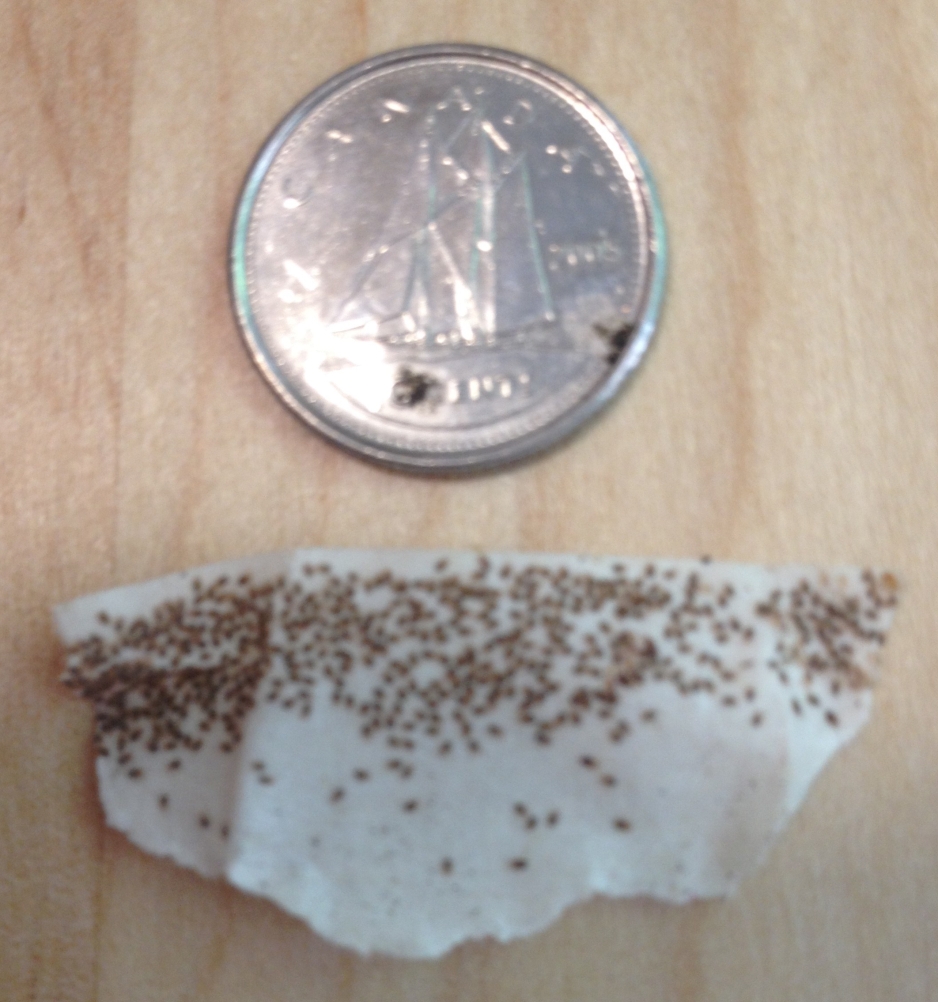
Mite sample acquired using a lint roller.
A dime is about 1.8 cm in diameter so I estimate the density of mites in the high-density area along the top of the sample to be about 200 per square centimetre. After the nestlings had left the nest, there was extensive coverage of the light as well as 4 or 5 patches of packed mites on the siding. Estimating the visible coverage at around 200 square centimetres that would mean about 40,000 mites. This is just the visible areas and the hidden areas on the light fixture. Any mites on the nest or the nestlings are not included though one might expect both to be heavily infected. My best estimate for the total mite count is somewhere between 50,000 and over 100,000.
We have a Wild M11 microscope which I used to get a better look at the mites. Using my iPhone camera, I was able to take some surprisingly good pictures. The following image was taken at the lowest (4X) magnification:
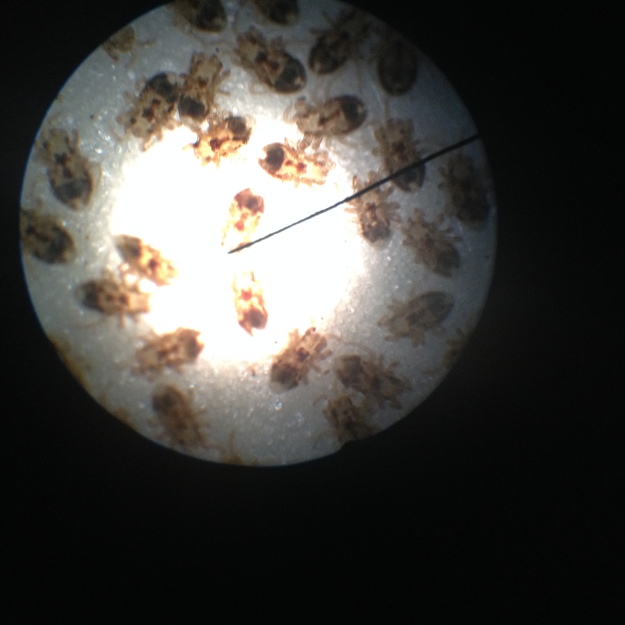
The wire has a length of about 2.2 mm at this magnification (calibrated with a plastic ruler) making the mites’ length about 0.6 mm. The next image was made at the next highest magnification (10X). Unfed mites are clear so this looks like a mite that has fed on blood — nestling blood most likely.
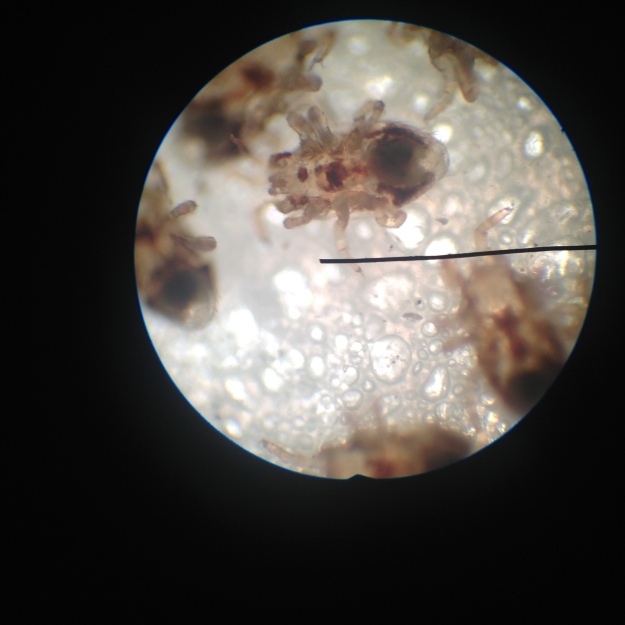
The two most common North American bird mites are the Northern Fowl Mite (Ornithonyssus sylviarum) and the Chicken Mite (Dermanyssus gallinae) which goes by several other names such as the Red Mite, Red Fowl Mite and Red Poultry Mite. Both are of great interest to the poultry industry because of the costly damage they can do. Both can infect wild bird species. From various sources I have read, I concluded that the flycatcher nest was probably infected with the Northern Fowl Mite.
The best reference that I found summarizing issues around bird mites and humans comes from a 2010 document from the PennState, Department of Entomology series of short Entomological Notes simply titled BIRD MITES (accessed July 28, 2017). Below, I quote a few of the more relevant paragraphs and highlight important sections that helped me handle the flycatcher mite infestation:
Bird mites are very tiny, flattened parasitic arthropods in the order Acari. They belong to two closely related genera in two families; Dermanyssus species in Dermanyssidae (Fig. 1), and Ornithonyssus species in Macronyssidae. Bird mites have piercing mouthparts that enable them to take blood meals from their bird hosts. Although the mites will inadvertently bite people, they cannot reproduce without their bird hosts.
DESCRIPTION
Bird mites have five stages: egg, larva, protonymph, deutonymph and adult. The larvae have three pair of legs; the nymphs and adults have four pair. Adults are about 0.7 to 1 mm in length and are just barely visible to the naked eye. Unless they are moving, they are extremely difficult to see. The color is translucent white until they take a blood meal after which the mites are reddish mahogany to brown. Mite eggs are white, oval and cannot be seen without the aid of magnification. The same applies to the larvae and nymphs.
LIFE HISTORY/BEHAVIOR
Most bird mite species can complete development in five to twelve days with optimal temperatures and host presence. This short life cycle makes it is possible for mite populations to attain tens of thousands of mites in bird nests during the rearing of young birds. If the population is too large (or if the fledglings vacate the nest or perish), the mites will migrate in mass to locate an alternative host. It is during this migration that mites can and do enter the living quarters of people. Some mites (i.e. Dermanyssus gallinae, the chicken mite) can survive for several months without taking a blood meal; the northern fowl mite, Ornithonyssus sylviarum, for several weeks. However, the mites do not appear to survive for more than several days in the reduced humidity (<35%) environs typically found in air-conditioned or dehumidified homes.
…
MANAGEMENT
Birds should be discouraged from building nests in or adjacent to buildings. Close all openings large enough for birds to enter attics, sof ts and similar areas. Install hardware cloth, sheet metal, or other materials to prevent birds from nesting and roosting on porches, breezeways and other exterior sites. Disrupt nest-building efforts by removing partially completed nests in shrubbery and on air conditioners and windowsills.
If mites are detected in the structure, locate the bird nest source. Remove the nest.
…
My take home message was to monitor the mites both around and away from the nest and be prepared to remove the nest and sanitize the nest area once the nestlings had left the nest to prevent the host-less mites from moving inside the house looking for new targets. I read some accounts of the problems that resulted from houses that became infected by bird mites (readily available on the websites of many extermination companies) and they definitely made me want to keep the mites outside.
Beside the visual evidence of an exploding mite population, the nestlings became increasingly restless as the quantity of mites increased. Frequent episodes of scratching were noticeable on the webcam videos.
My personal belief is that the nestlings left the nest early, before the were ready to fledge, in large part because of their discomfort from the mites. I know that one nestling perished because I found the body on the morning of July 24. The last sighting of a nestling was on the morning of July 25. The last sighting of the female adult sticking close to its foraging area near our house was on July 25.
One final reason why I do not think that there were any surviving nestlings was the presence of a domestic cat nearby. The day that I found the dead nestling, it was lying in our driveway when I returned home from some errands. I have seen the cat, before and since, in and around our yard. An unfledged nestling hopping in the bushes would have had little chance of avoiding the feline if it were spotted.
I have listed below some of the interesting references that I found online.
[1] This 2005 reference contains some good high-level information on mites: Common Lice and Mites of Poultry: Identification and Treatment.
[2] One of the best short summaries on bird mites that I have found: UW Madison Department of Entomology information sheet.
[3] Good reference from Iowa State University: Bird-Mites.
[4] A good 2014 review article: Mites and birds: diversity, parasitism and coevolution.
July 21: As of yesterday the Pacific-slope Flycatcher nestlings are 10 days old. Their eyes are opening and feathers are starting to show. They also appear much more restless than in previous days and I’m a little worried that one might fall out of the nest. It’s more than 6 feet down to the concrete steps so a fall would, I imagine, be fatal.
The adult birds spend most of their time foraging and only at the nest for a few seconds every few minutes. So, I thought that I’d try to get a better between-visits picture of the nestlings with my Panasonic FZ-200 camera whose 24x optical zoom lets me fill the image whereas the Logitech 920 webcam, used for my videos, has no optical zoom so cropping is the only way to “zoom in” and that results in a lower resolution image. Here is the best picture that I was able to take:
I had just focussed on the nestlings, who were alone in the nest, when the adult male flycatcher appeared in the foreground. Because of the low-light I was using a large aperture with poor depth of focus which put the adult bird slightly out of focus. It’s a nice subtle effect.
The camera picture also highlights something else not so nice. If you look closely at the vinyl siding behind the nest you can see a number of small black specks. Reviewing the webcam videos shows that these specks are actually moving around. They are concentrated around the nest suggesting that they are some form of parasite associated with nest and birds. I reviewed previous days’ videos but July 21 was the first day that the specks were visible. My suspicion is that they are bird mites which Doctor Google tells me would not be a good thing. More research needed.
I was taking the 11:00 am ferry from Tsawwassen to Schwartz Bay when a loon near the boat decided to take flight. I captured a bit of it with my camera in burst mode with a shutter speed of 1/800. You can get a good sense of the cartoon “running on water” take-off. Perhaps I should call it a Looney Tunes take-off.



Back in August of this year, the 14th to be exact, I was walking along the waterfront in Sidney, BC when I caught a gull red-handed (or red-billed) trying to swallow a sea star. Here’s the sequence of 4 pictures that I took over a half-minute or so:
The gull does not seem to be having a lot of success.
Then, I was looking through some older images yesterday and found another sequence of 4 images taken in March 2016 at Neck Point Park in Nanaimo:
The first image shows the gull with the sea star in its mouth. The following three images show the gull swallowing the sea star. It had to extend its neck which, as you can see by the white spot on the rocks appearing in the third image, triggered a ‘movement’.
I sometimes wonder why I don’t get bored going to the same birding locations month after month, year after year. A big part of it is that, on any given day, there is a chance that they will see something different or rare or perhaps even totally new.
This past Sunday, while on an organized outing with a bunch of local birders to Buttertubs Marsh Bird Sanctuary in Nanaimo, I got my “something-new” fix. In this case is wasn’t a new species of bird — instead it was an inter-species interaction that I had never noticed before – that of an American Wigeon stealing food from an American Coot.
The first of the two species, the American Wigeon (Anas americana), is a duck that is part of the genus Anas sometimes referred to as dabbling ducks. These duck may feed on land or on the water where they can tip themselves upside down and gather underwater plants up to several inches below the surface.
The second of the two species, the American Coot (Fulica americana), is in the family Rallidae of rails and looks a little like a small black chicken. These birds may feed on land, by dabbling in shallow water or by diving for plants.
I captured a short video of the food stealing behaviour (kleptoparasitism) with my Panasonic DMC FZ-200 camera. I may have had too much fun and gotten a little carried away with the presentation. You be the judge:
At one point there were at least 3 or 4 Wigeon-Coot pairs doing similar food-stealing dances.
On another occasion I watched as a Wigeon tried to manage two Coots at the same time and seemed to spend a lot of time in the middle trying to decide which way to go. Not a good strategy for a low-intelligence bird it would seem.
Some further comments and other notes resulting from forays into online ‘research’:
A good source of information that I like to use is the Birds of North America online service from the Cornell Lab of Ornithology. The service is not free but for anyone curious about bird behaviour it’s worth the price in my opinion. They have a one month subscription that costs $5 if you want to give it a try.
[1] BNA online article on the American Wigeon.
[2] BNA online article on the American Coot.
[3] H. Jane Brockmann & C. J. Barnard, Kleptoparasitism in birds, Animal Behaviour Research Group, Department of Zoology, University of Oxford, UK
Animal Behaviour (Impact Factor: 3.14). 05/1979; 27:487-514. DOI: 10.1016/0003-3472(79)90185-4
[4] Juan A. Amat & Ramón C. Soriguer, Kleptoparasitism of Coots by Gadwalls, Ornis Scandinavica 15: 188-194. Copenhagen 1984.
I made my first post-election birding trip yesterday. A friend, who I’ll refer to by his initials LR, and I set our Nanaimo itinerary to take us on a loop including Neck Point, Pipers Lagoon, the Nanaimo River Estuary and Buttertub Marsh.
We should have known better as we only made it to Neck Point and Pipers Lagoon spending more than two hours at those two sites. We did add the Linley Valley Drive Wetlands which is walking distance from our house.
As usual, I had both camera and binoculars at hand. Birding was enjoyable and I did get a couple of nice pictures that I’ll share.
We arrived at Neck Point and had barely got out of the car when the buzzing (for an example play this recording of a Bewick’s Wren on Xeno-Canto) of a Bewick’s Wren was heard. There was actually a pair flitting around near the parking lot and they were surprisingly unafraid bopping around in plain site. Here is one checking me out:
Note that I rely heavily on the auto-focus feature of my camera (Panasonic FZ-200). When taking of pictures of fast moving birds, especially when they are in bushes the auto-focus does not always behave. Here is an example:
Apparently the camera liked the road-side pebbles better.
We saw a total of 14 species at Neck Point (eBird checklist)
Pipers lagoon was more productive producing a total of 23 species (eBird checklist). The picture bird, a male Hairy Woodpecker, was again located first by sound (here’s a recording of a Hairy Woodpecker on Xeno-Canto). Here’s a picture that shows the long bill (compare with the shorter bill of its smaller look-alike cousin the Downy Woodpecker):
The final picture, while not of the highest quality because it was taken at full zoom, proved to be useful for the identification of a pair of gulls sitting on a small rock offshore. The yellowish legs and plumage suggested a California or a Mew gull. Studying the picture later suggested that it was a Mew Gull. Check it out for yourself:
A two minute walk from my house is a small wetlands surrounded by housing developments in various stages of completion. We spent about a half hour walking the path that runs along one side of the pond and saw some interesting birds (5 new species for the day) including a Hooded Merganser pair, Ring-necked Ducks, a Fox Sparrow, Chestnut-sided Chickadees (surprisingly not seen at the other two locations) and a Pied-billed Grebe. The site total was 12 species (eBird checklist)
On our last day in Hawaii we negotiated a late checkout (noon) but still had many hours to kill until our red-eye left just before midnight. One of the things that we had not yet done was see some Sea Turtles so, after a little research, we visited the Kaloko-Honokōhau National Historical Park which is about 2 miles (3 kilometres) south of the Kona International Airport. We went into the main area just off of the Queen Kaahumanu Highway but when we said that we were looking for turtles they sent us out to the main highway to enter at the South edge of the park along a road called the Kealakehe Parkway. Eventually you turn right off of this road in the direction of the Honokohau Beach.
When we got there it only took a few seconds to find some Green Sea Turtles as they were within feet of the shoreline foraging. It didn’t hurt that there was another person wading only inches from one of the turtles taking pictures. The turtles did not seem to mind our presence which made taking their picture quite easy. The hardest part was being ready when they raised their head out of the water for a few seconds every few minutes.
The following three pictures show some different views of the turtles. The first shows an entire turtle (they are about 3 feet long) at the water’s surface looking for food on the bottom. The second shows a turtle with head up. The camera was zoomed in so that only the front half is visible. Finally, the third turtle was photographed with its head up as well but this time the camera was zoomed in such that the head almost fills the image.
Note that the bottom 2 images were cropped to have an aspect ratio of 1.6 which is common to many computer displays. As a result, both of them make for a pretty cool desktop background or wallpaper!
Enjoy!
[Updated December 10 2014 based on feedback. Additional links on the Palila have been added.]
A recent week-long vacation took us to the Hawaiian Islands (October 26 to November 1). Having previously been to the island of Kauai at the old end of the island chain, we decided to try the island of Hawaii at the other, newer end. To prevent confusion with the state of Hawaii this is frequently referred to simply as the Big Island. I had my Panasonic FZ-200 camera along to document the trip.
On the last full day, I signed up for a Rainforest and Dryforest Birding Adventure tour — a day-long outing put on by a tour group called Hawaii Forest and Trail. They do many other tours too that are not just for birding. The rest of our group, for instance, went on the Mauna Kea Summit and Stars Adventure trip which takes you up to the volcano’s summit to watch a sunset.
Our trip set out in search of 2 specific target birds. In the dry forests on the side of Mauna Kea we would be looking for the Palila, a critically endangered species which lives in a single forested area on the volcano’s slopes. This forested area is the source of the māmane plant which the Palila has adapted to be able to eat and which is toxic to other birds.
In the second part of our excursion, we would travel to some wetter forests where we hoped to find different endemic, the ʻAkiapōlāʻau.
While we were, unfortunately, unable to track down the ʻAkiapōlāʻau, we were extremely successful with the Palila and the rest of this article describes that encounter.
First, a quick note and the Palila habitat on the slopes of Mauna Kea.
Mauna Kea is still considered to be an active, though dormant, volcano and even though it has not erupted in 4600 years there is still the slim possibility that a lava flow from a future eruption could wipe out this habitat leading to their extinction. While this might make for a good story in Hollywood, the reality is that there are much more dangerous risks that could well see the Palila gone from these slopes long before they are touched by lava. Forest fires, for instance could, in the right conditions, very quickly destroy the Palila habitat. Other threats include introduced species of plants, animals, insects and disease. The Hawaiian government’s Mauna Kea Forest Restoration Project has lots of good information here. Finally, according to BirdLife International, the endangered status of the Palila in recent years is also related to rapid population declines as a result of drought that has affected its primary source of food, the māmane plant.
The plan was simple. We parked in an area accessed by a hunter access road on the lower slopes of Mauna Kea. The trip organizers allowed for up to 4 hours climbing the slopes to find and view the Palila after which time, win or lose, we would head for the second location.
Here is a picture taken near our parking spot and at the lower edge of the area expected to contain the Palila. Note the sparse trees on fairly open grassland.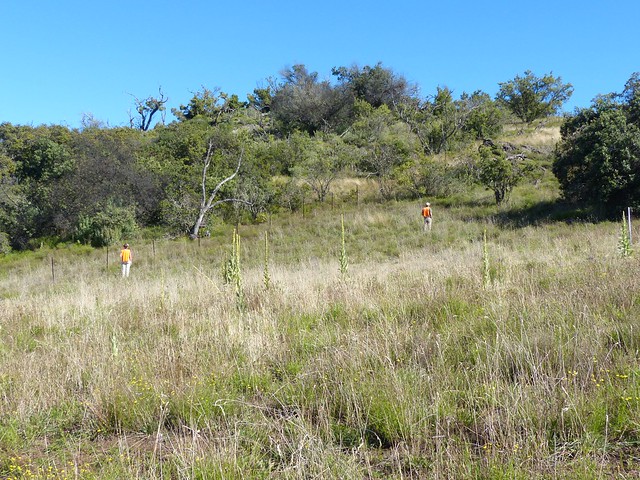
Here is a second shot taken as we climbed a little further up the Mauna Kea slope.
According to the guide, on one recent trip they spent most of the allocated time hunting for the Palila and only found them as they were about to quit and move on. We got lucky and found one after about 15 minutes with another pair showing up shortly thereafter. In fact it appears that we had found a family unit with male, female and juvenile foraging together. The juvenile showed typical begging behaviour with fluttering wings and an adult was doing the foraging and feeding of the juvenile though regurgitation as described, for instance, in a Palila wikipedia article. This article says that both adults will regurgitate to feed the young in our case the male was feeding while the female stood guard, presumably looking for predators. If the wikipedia article is correct then perhaps they take turns feeding and guarding or perhaps the guarding behaviour only happens occasionally, for instance when a large number of two-legged, orange-vested homo sapiens are also foraging in the area.
If we only consider predators seen historically before the arrival of man on the islands the most likely candidates would probably have been the Hawaiian Short-eared Owl (Pueo) and the Hawaiian Hawk (ʻIo). It is not clear what threat we birders posed to the Palila though it was clearly not enough to drive them away. Whether or not the female would have stood guard where and when she did if we had not be there is unclear.
As mentioned earlier, introduced predators are currently one of the Palila’s biggest threats. These include feral cats and black rats (see for instance this article on the Palila from BirdLife International (birdlife.org). Mosquitos transmitting avian malaria have also proved very dangerous to the endemic populations of birds. They are also threatened by habitat degradation especially if it affects the growth and spreading of their primary food sources, the peas from the seed pods of the māmane plant and certain types of caterpillar. Introduced mammals such as sheep and pigs are particularly bad for disturbing the forest plants. Through hunting and fencing the threat of these has been reduced.
Our first sighting of a Palila was that of an adult male who was processing a māmane pod in the middle of a bush that provided the bird with some protection. The following 7 pictures, shown in the order that they were taken, cover a period of about 9 seconds. All of these pictures were cropped from the original size of 4000 x 3000 down to about 1200 x 800. The displayed images below are shown at a resolution of 640 x 400 though the full-sized cropped images can be viewed clicking on the image and following the link back to Flickr.
The following is a short video that was taken starting 10 seconds after the last picture (above) was taken. You can hear the group leader describing the bird to some of the birders that were just then discovering it for the first time. Initially you can see the Palila alternating between working on the māmane pod and raising it’s head up to check its surroundings.
You can also hear the Palila in between the periods where it is working on the māmane pod and also after it appears to be done having released the māmane pod. Perhaps these calls were communications to the other family members that would be showing up in the seconds that followed the video. There may even have been a specific message to the juvenile that he (the adult male) was full and that it was time to eat. This might also explain why he dropped the pod. It’s not clear why they moved to a different location for the feeding. Perhaps it was because of our presence or perhaps because it is generally safer to keep moving.
Unfortunately there is a half minute gap between this series of pictures and the next series with adult feeding juvenile. The only thing that I recall from this period is that the juvenile and adult female arrived to join the adult male and then the female left again.
The second set of 7 images were taken over a period of 13 seconds starting 63 seconds after the last picture in the first set or about 38 seconds after the end of the short video. As mentioned, in these 38 missing seconds the male moved to a different perch and a juvenile and an adult female flew in to join the adult male. Only the juvenile stayed to be fed by the adult male while the female flew off to, it appears, stand guard (see the third sighting section below).
The sequence between the adult male and the juvenile clearly shows the begging behaviour as well as the regurgitation and transfer of food from adult to juvenile.
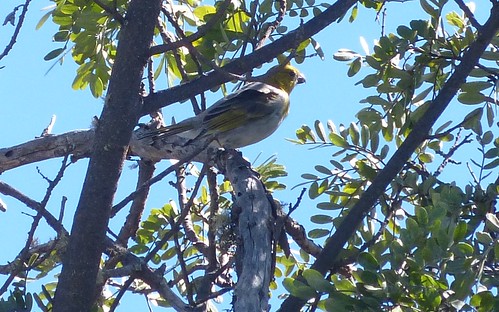
The final image was taken 5 seconds after the previous one and shows the juvenile left alone and somewhat hidden in the foliage while the adult male had moved on, perhaps to start a new cycle of processing māmane pods prior to the next feeding cycle at which point he would call the juvenile to join him there.
The third set of 5 pictures were taken over a period of 24 seconds starting 18 seconds after the last image in the second set.
The adult female Palila, which made a brief appearance off camera took up a position 100 feet or so from where the other two birds were positioned. Her perch at the top of a bare branch gave her good visibility. She chose a bush that kept all of the birders, which had broken into several groups by this time, on one side of her, perhaps in order to be able to see all of them at once without continually having to look in opposite directions. As the photos show, she still does look away from time to time, perhaps scanning for other possible threats. As mentioned previously, the two historic threats where probably the Hawaiian Short-eared Owl (Pueo) and the Hawaiian Hawk (‘Io). At this point in our trip we had already seen 5 of these owls hunting (one near where we found the Palila) and we had one unconfirmed hawk sighting.
I was impressed by the fact that both adult Palilas were caring for what was clearly a juvenile bird. The splitting of the task of feeing the young was split into roles of foraging and standing guard. It would have been nice to know if they switched roles from time to time. Many species, particularly migratory ones, leave their young to fend for themselves at a much younger age or only one of the adults take responsibility for the young.
I acquired my Panasonic FZ-200 camera to help with bird identification but on several occasions it has proven useful in seeing behaviours that I would never have noticed using just binoculars. The ability to capture large numbers of pictures and even videos with sound provides the opportunity to analyze different aspects of bird sightings that happen too quickly in the field.
It would seem that my camera is rapidly replacing my binoculars as my primary birding equipment. Here are some things that I might change in the future that might lead to better results:
It was a fun way to get introduced to a new bird and, while it took a lot of time post-processing, it was definitely more satisfying than a brief sighting and a simple pencil mark on a checklist.
The Palila article on Wikipedia.
The Palila Status at BirdLife International (birdlife.org).
The Mauna Kea Forest Restoration Project website from the Hawaiian state government has much more detailed and accurate information on current status and threats to the Palila.
The Facebook page for “A Paradise Lost”, an animated movie about the Palila directed by Laurie Sumiye.